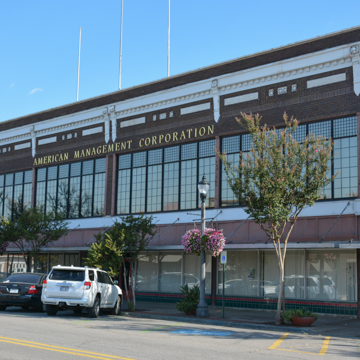You are here
American Management Corporation
In the 1920s Sanders and Ginocchio converted two buildings into a reinforced concrete and brick department store. Plate glass windows line the ground story, and the upper floor is composed almost entirely of windows, with transoms of prism glass to throw light deep into the store. Interestingly, the combination of the second-story mullioned windows with the brown brick surround has a hint of the industrial structures of Detroit’s Albert Kahn in contrast to the more traditional classical approach to department store design in the 1920s. Above the upper-story windows the red brick walls are attractively decorated with Craftsman details and a dentiled cornice.
The store originated in a mercantile business that German immigrant Max Frauenthal established in 1879 in a two-story building on this site shortly after Conway was founded in 1871 on the Little Rock and Fort Smith Railroad line. In 1892, Frauenthal sold the company to his cousin Jo Frauenthal and Leo Schwarz, who in 1915 hired architect Charles L. Thompson to remodel the facade. Business prospered, and in the 1920s they purchased the building adjoining their store. This gave them one hundred feet of street frontage, and they hired Sanders and Ginnochio to remodel the building. The building was renovated in 1989.
Jo Frauenthal’s house (1913) at 631 Western Avenue is also a Charles L. Thompson design. It is Colonial Revival with Mediterranean touches and includes a projecting pedimented portico with four giant Tuscan columns.
Writing Credits
If SAH Archipedia has been useful to you, please consider supporting it.
SAH Archipedia tells the story of the United States through its buildings, landscapes, and cities. This freely available resource empowers the public with authoritative knowledge that deepens their understanding and appreciation of the built environment. But the Society of Architectural Historians, which created SAH Archipedia with University of Virginia Press, needs your support to maintain the high-caliber research, writing, photography, cartography, editing, design, and programming that make SAH Archipedia a trusted online resource available to all who value the history of place, heritage tourism, and learning.















